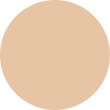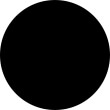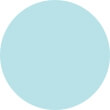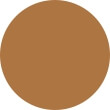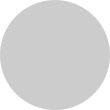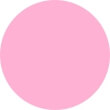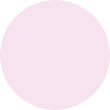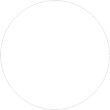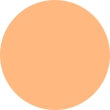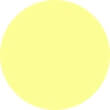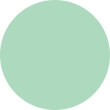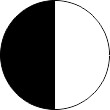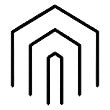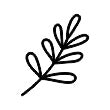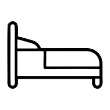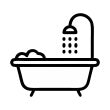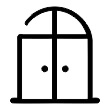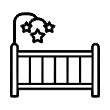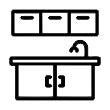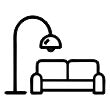Safety Information
This Safety Disclaimer applies to all removable peel and stick wallpapers, regardless of the brand, unless explicitly stated otherwise by the manufacturer for textured walls.
Traditional wallpaper hanging might be a hassle, but removable peel-and-stick wallpaper will make your life much easier. Though there is little concern that you will err, knowing what you are getting into is vital before you begin.
Applying removable peel-and-stick wallpaper to damaged, textured, or freshly painted walls is NOT Advisable. Everything seems to be in place once the wallpaper has been mounted on these walls.
They appear to be attached for a few days or even weeks. Slowly they start bubbling up and eventually collapse abruptly, flaking off from the wall. A bed or crib in the path of falling wallpaper poses a suffocation risk to babies.
The materials used to manufacture our high-quality peel-and-stick wallpaper are water, cellulose fiber, resins, and adhesives. These materials are safe for children and will not cause any harm. Peel-and-stick wallpaper doesn't irritate the baby's skin.
|
Our self-stick wallpapers are free of lead, VOCs, PVC, and other toxic chemicals that could degrade the quality of the indoor atmosphere in your house. |
Smooth or canvas wallpapers are used only for dry application. Avoid using either water and detergent or a commercial application fluid to position the graphic.
Why Are Peel And Stick Wallpaper On My Walls Flaking Off?
- Not Smoothing Your Wallpaper Designs: When installing peel-and-stick wallpaper, it's crucial to press firmly on each panel in order to properly smooth the vinyl. If not, you might notice the wall lift.
- You Have Dirty Or Dusty Walls: Walls can be good for interior designs, but they are excellent dust collectors, especially when upgrading your home. The wall must be cleared of lint, oils, or other grime before installation, and it must dry for 24 hours.
If the walls aren't clean before you install removable wallpaper, the glue won't work, and the wallpaper will start peeling off.
- Having Mold Or Humidity Spots On The Wall: Wall coverings can trap moist air, which can cause bubbles to form if any dust or other foreign objects become trapped underneath during installation. Humidity will eventually drive air to surround that object, causing the wallpaper to peel.
Wallpaper can readily fall if the relative humidity rises beyond 50%. As long as a bathroom has a window that can be opened or a fan that can be turned on to reduce excessive humidity, the peel-and-stick wallpaper should last.
- Newly Painted Walls: You should wait at least four to six weeks after painting your walls before applying peel-and-stick wallpaper. This will give the paint time to fully cure. Paint fumes can linger for weeks after painting, even with low-VOC paints.
Those vapours have nowhere to go and will cause enormous bubbles in your wallpaper, damaging the glue.
To fix the issue, mix 70% isopropyl alcohol with 30% water, clean the wall with the solution, let it dry, and test the adherence. If it passes, continue with the wallpaper installation.
- Cracked Or Damaged Walls: The purpose of our wallpaper is to cover the wall rather than fix it. Wallpapers cannot be used to permanently cover too much wall damage. Please check the condition of your walls before hanging wallpaper.
Case Study: Removable Wallpaper
Removable wallpaper utilizes a specialized adhesive that offers excellent structural resistance, but it is known for having a relatively low grade of adhesion, often referred to as "low-tack." This characteristic enables easy removal without causing any damage to the underlying surface and allows for seamless replacement. However, it also means that the adhesive requires a full contact surface to maintain its hold.
A critical consideration is that each panel of this wallpaper can weigh up to 2 pounds. For a low-tack adhesive, attempting to support two pounds vertically without a strong attachment will result in the wallpaper falling off or not sticking effectively. Therefore, it is essential to ensure proper surface preparation and adequate adhesion to prevent any issues with the wallpaper staying securely in place.


Our Adhesive Wallpaper Comes In Four Different Types
- Smooth Peel-and-stick Wallpaper
- Canvas Peel-and-stick Wallpaper
- Smooth: Unpasted
- Canvas: Unpasted
How To Hang Peel And Stick Wallpaper? (Insert Video)
Before you start, remember that peel-and-stick wallpaper often best sticks to smooth, eggshell, satin, or semi-gloss finished walls. To ensure the product will adhere to your walls, check the manufacturer's instructions for the wallpaper.
Carefully measure the area you intend to cover in removable wallpaper to ensure you purchase the appropriate amount. Buy extra wallpapers than you think you'll need to account for errors and tricky areas like windows, doors, or small nooks.
TEXTURED WALL EXAMPLES YOU SHOULD AVOID
The structural integrity of removable wallpapers is strong, but wallpapers are low-tack on textured walls with cracking paint, damp spots, knockdowns, orange peel textures, popcorn texture or other imperfections and attach poorly to them.
Removable wallpapers are used on both walls and ceilings. They should be applied only to smooth walls.
The numerous dips, holes, and gaps in textured walls reduce the surface area that can make contact with the wallpaper. Wallpaper on textured walls is more likely to fall off.

Please remember that we have not had any dangerous incidents with our product. We work hard to ensure the baby's safety and a lasting installation, in addition to having ecologically friendly items.
Frequently Asked Questions
Is Our Peel-And-Stick Wallpaper Fire Retardant?
Ans: There is no such thing as fire resistant wallpaper, but some types are more resistant to fire than others. Class A wallpaper is the most resistant to fire in laboratory tests.
Our Peel and Stick wallpapers are fire-retardant and don't burn as quickly as similar quality wallpapers, making them much safer.
What Type Of Ink Is Used In Making Our Wallpaper?
Ans: We use HP Latex Inks - BERTL, UL GREENGUARD, ECOLOGO certified. Also, the ink which we use to print the wallpaper is Odorless.
Here you can write that they are safe for kids.
Which Type Of Material Is Used In Printing The Wallpaper?
Ans: Our wallpapers are made of Vinyl material which is quick and easy to install & Non-Toxin. Best for DIY projects. We use Calliper, face film & adhesive ISO 534 - 111 microns.
Are Wallpapers Resistant To Acids Or Alkalines?
Ans: Our wallpaper is resistant to most mild acids, alkalies, and salt solutions.
Do Your Wallpaper Eliminates Bubbles Or Wrinkles?
Ans: We have developed easy apply™ adhesive technology with air egress channels to eliminate bubbles and wrinkles during application.
Are Your Wallpapers UV Resistant?
Ans: Yes! Our wallpapers are UV-Resistant which will enhance the long-lasting print.
Are The Wallpapers FSC® Certified Paper?
Ans: Yes, our wallpapers are FSC® certified paper from well-managed forests. Forest Stewardship Council certification system ensures the sustainable management of virgin paper production.
